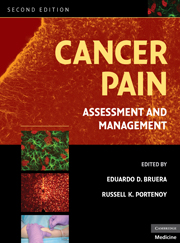Book contents
- Frontmatter
- Contents
- Contributors
- Preface
- SECTION I MECHANISMS AND EPIDEMIOLOGY
- SECTION II EPIDEMIOLOGY AND SYNDROMES
- 3 Cancer pain epidemiology
- 4 Cancer pain syndromes
- SECTION III ASSESSMENT
- SECTION IV PHARMACOLOGICAL TREATMENT
- SECTION V OTHER INTERVENTIONAL STRATEGIES
- SECTION VI REHABILITATION AND PSYCHOLOGICAL INTERVENTIONS
- SECTION VII THE ROLE OF ANTINEOPLASTIC THERAPIES IN PAIN CONTROL
- SECTION VIII PAIN IN SPECIAL POPULATIONS
- SECTION IX DIFFICULT PAIN PROBLEMS
- SECTION X SYSTEMS OF CARE
- Index
- Plate section
- References
3 - Cancer pain epidemiology
from SECTION II - EPIDEMIOLOGY AND SYNDROMES
Published online by Cambridge University Press: 06 July 2010
- Frontmatter
- Contents
- Contributors
- Preface
- SECTION I MECHANISMS AND EPIDEMIOLOGY
- SECTION II EPIDEMIOLOGY AND SYNDROMES
- 3 Cancer pain epidemiology
- 4 Cancer pain syndromes
- SECTION III ASSESSMENT
- SECTION IV PHARMACOLOGICAL TREATMENT
- SECTION V OTHER INTERVENTIONAL STRATEGIES
- SECTION VI REHABILITATION AND PSYCHOLOGICAL INTERVENTIONS
- SECTION VII THE ROLE OF ANTINEOPLASTIC THERAPIES IN PAIN CONTROL
- SECTION VIII PAIN IN SPECIAL POPULATIONS
- SECTION IX DIFFICULT PAIN PROBLEMS
- SECTION X SYSTEMS OF CARE
- Index
- Plate section
- References
Summary
Introduction
Cancer pain afflicts millions of people worldwide every year, yet it can be well or completely controlled in 80%–90% of patients. Exactly how many of the estimated 6.6 million people worldwide who died from cancer last year experienced pain at any one time is difficult to ascertain. The reasons for this are discussed in the following text. Nevertheless, in spite of the major advances in pain control over the past 15 years, cancer-related pain continues to be a major international public health problem.
Although pain is recognized as an extremely common symptom in patients with cancer, studies to date show a wide variation in the reported prevalence. A systematic review of 19 studies recording the prevalence of pain in cancer found pain reported in 35%–96% of patients. Three main factors influence this variation:
Difficulty in making generalizations to different health care settings or different patient groups because of variation in the design of prevalence studies
Inherent difficulties in assessing the presence or absence of pain, particularly because no one “gold standard” assessment system exists, exacerbated by attempts to grade the severity of cancer pain in a variety of ways
Difficulty in defining the type of pain, because pain associated with cancer has features of both chronic and acute pain and can be either the direct or indirect result of the cancer
Pain and cancer are not synonymous. Evaluation of pain in advanced cancer is primarily clinical and is based on pattern recognition.
- Type
- Chapter
- Information
- Cancer PainAssessment and Management, pp. 37 - 52Publisher: Cambridge University PressPrint publication year: 2009
References
- 1
- Cited by



